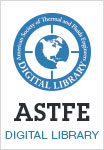
ISSN Online: 2379-1748
8th Thermal and Fluids Engineering Conference (TFEC)
NUMERICAL STUDY OF A SOLAR-ASSISTED SCO2 BRAYTON CYCLE FOR POWER GENERATION
Abstract
Power cycles based on supercritical carbon dioxide (sCO2) have the potential to yield higher thermal efficiencies at lower capital cost than state-of-the-art steam-based power cycles. sCO2 power cycles integrated with solar and thermal energy storage have shown significant potential to meet the needs of the current and future grid. Due to the importance of this research, three Department of Energy (DOE) offices are working together to reduce the technical hurdles and support foundational research and development of sCO2 power cycles. In
this research, a numerical simulation of a Brayton cycle is run with sCO2 as the working fluid. This system is integrated with a parabolic solar trough collector and a cooling tower to add regenerative heat into the system. Information taken from NREL's Systems Advisor Model (SAM) was used to simulate ambient conditions of Wilmington, NC for an entire year. Properties for sCO2 are generated from the National Institute of Standards
and Technology's (NIST) REFPROP database. Different parameters are observed during this study; turbine inlet temperatures, solar irradiance, compressor inlet pressure, and pressure ratio to analyze the performance of the system.